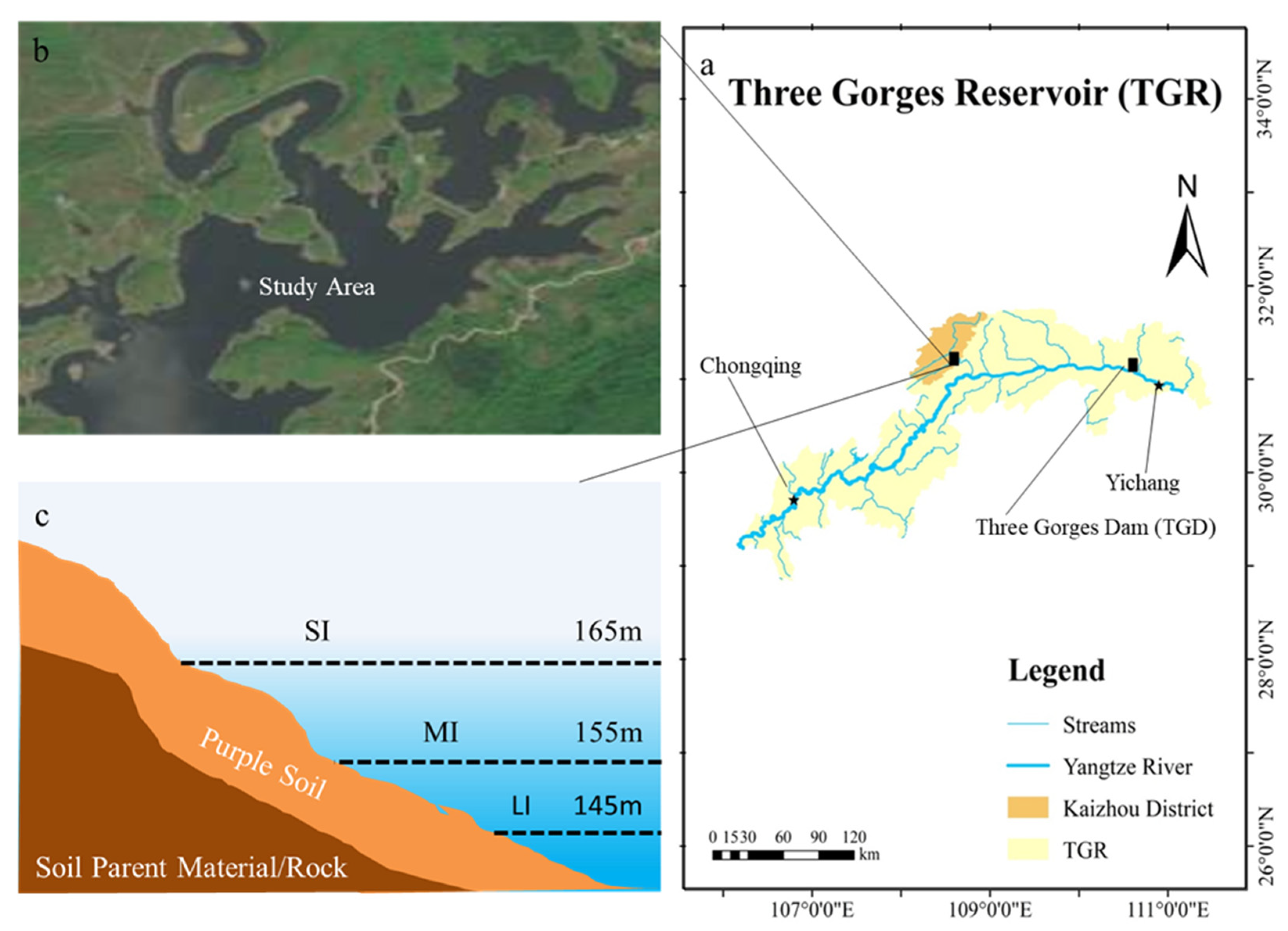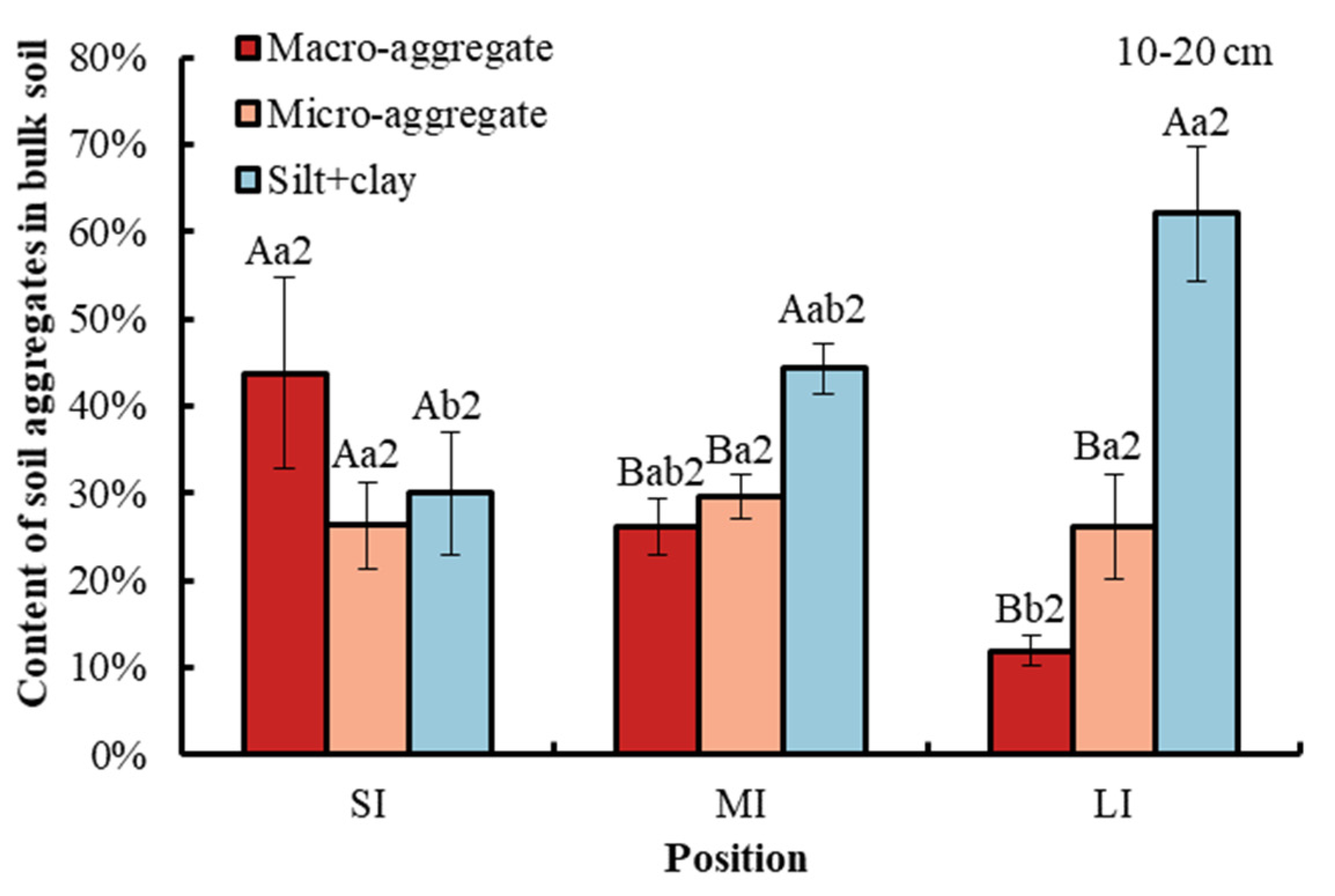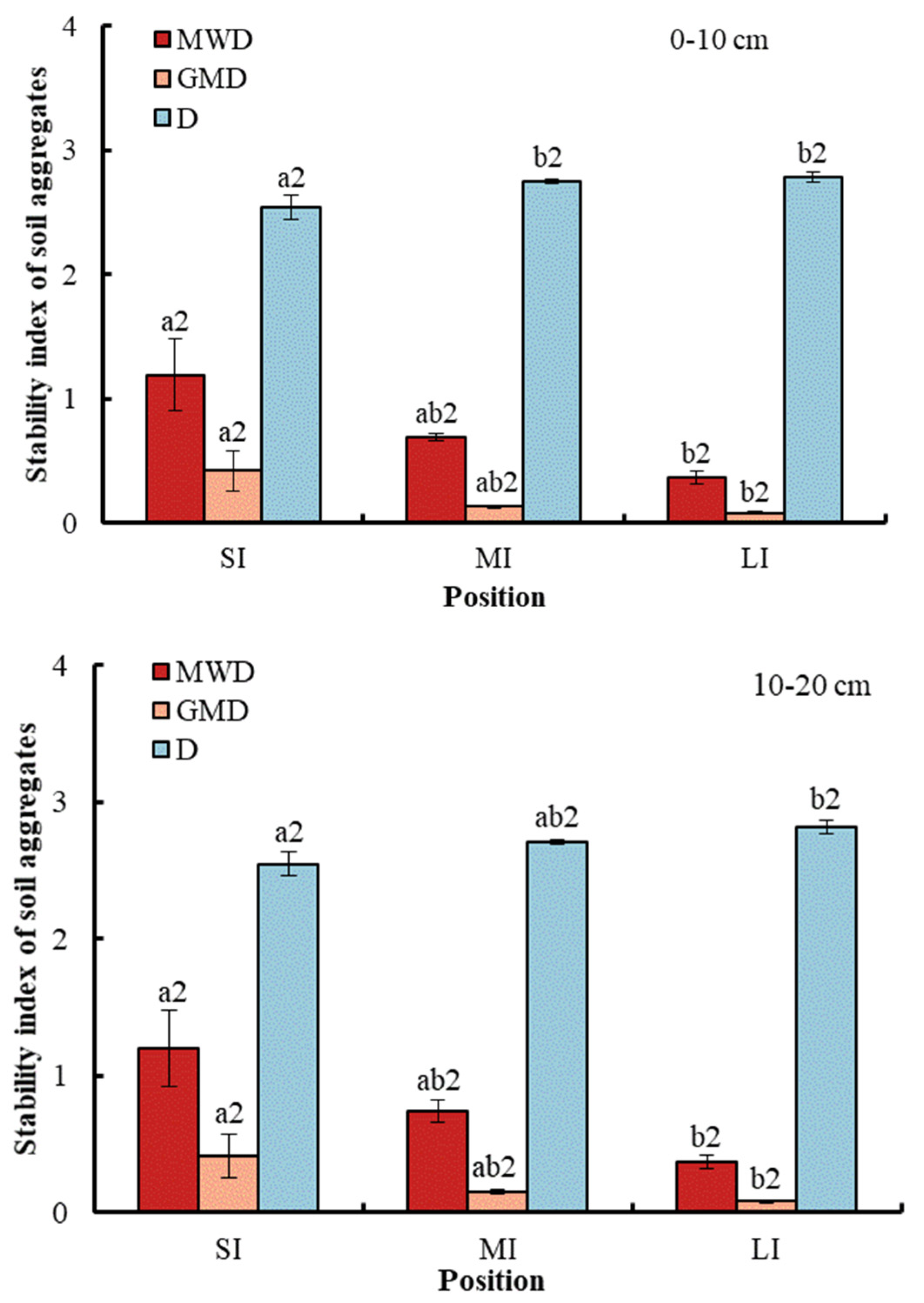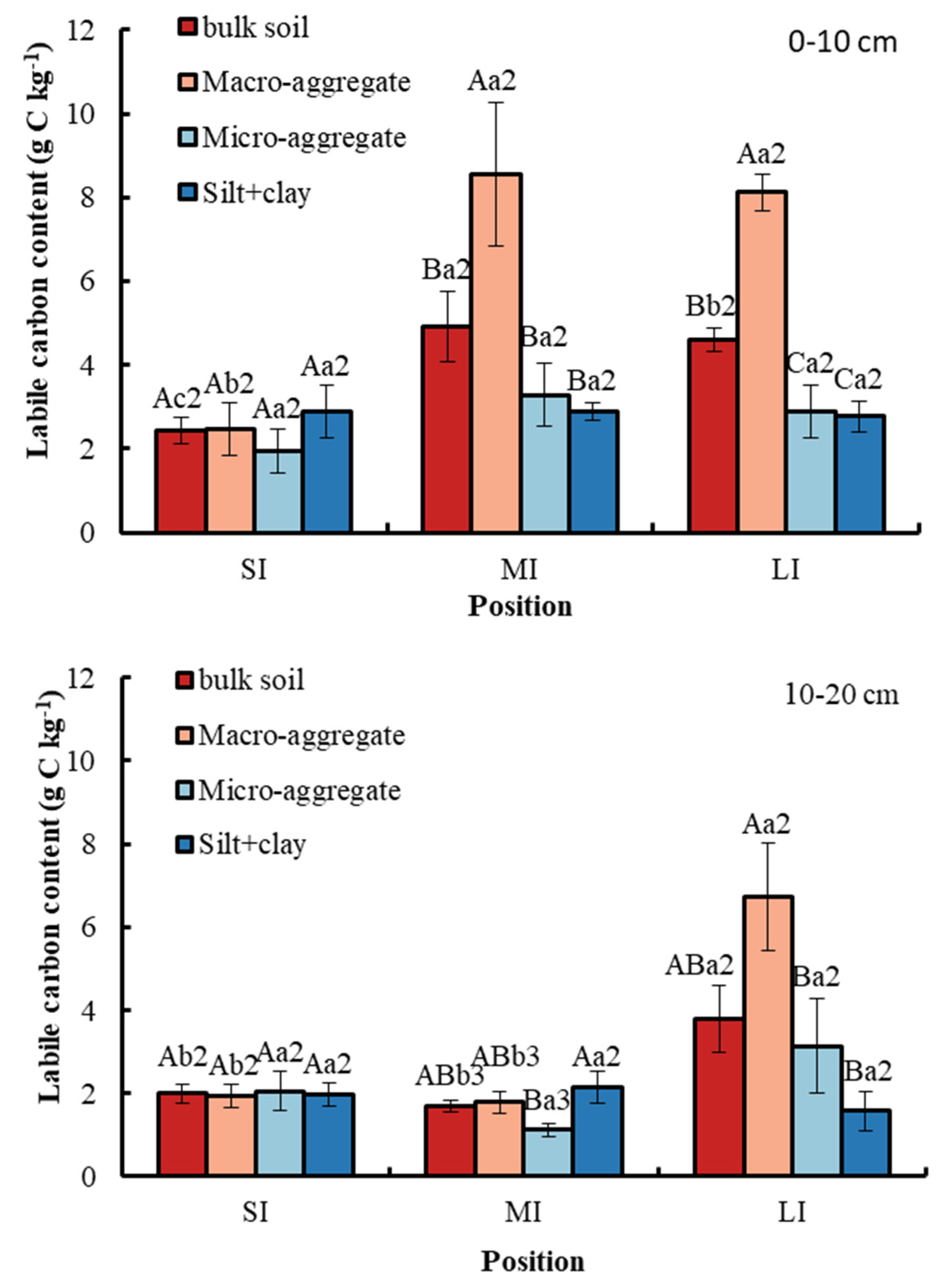Effects of Water-Level Fluctuation on Soil Aggregates and Aggregate-Associated Organic Carbon in the Water-Level Fluctuation Zone of the Three Gorges Reservoir, China
Abstract
1. Introduction
2. Materials and Methods
2.1. Study Area
2.2. Sampling Design
2.3. Soil Analysis
2.4. Statistical Analysis
3. Results
3.1. Content and Stability of Different Soil Aggregates in the Bulk Soil
3.2. Total SOC Content in the Bulk soil and Different Particle Size Aggregates
3.3. Labile Carbon Content in the Bulk Soil and Different Particle Size Aggregates
3.4. Contributions of Different Particle Size Aggregates to SOC Sequestration
3.5. Contributions of Different Particle Size aggregates to Labile Carbon Fraction
4. Discussion
5. Conclusions
Author Contributions
Funding
Data Availability Statement
Conflicts of Interest
References
- Chen, C.; Cheng, H.; Jia, J.; Wang, X.; Zhao, J. Use it or not: An agroecological perspective to flooded riparian land along the Three Gorges Reservoir. Sci. Total Environ. 2019, 650, 1062–1072. [Google Scholar] [CrossRef]
- Ran, Y.; Ma, M.; Liu, Y.; Zhu, K.; Yi, X.; Wang, X.; Wu, S.; Huang, P. Physicochemical determinants in stabilizing soil aggregates along a hydrological stress gradient on reservoir riparian habitats: Implications to soil restoration. Ecol. Eng. 2020, 143, 105664. [Google Scholar] [CrossRef]
- Nsabimana, G.; Bao, Y.H.; He, X.B.; Nambajimana, J.D.D.; Wang, M.F.; Yang, L.; Li, J.L.; Zhang, S.J.; Khurram, D. Impacts of water level fluctuations on soil aggregate stability in the three Gorges reservoir, China. Sustainability 2020, 12, 9107. [Google Scholar] [CrossRef]
- Tang, Q.; Bao, Y.; He, X.; Fu, B.; Collins, A.L.; Zhang, X. Flow regulation manipulates contemporary seasonal sedimentary dynamics in the reservoir fluctuation zone of the Three Gorges. Sci. Total Environ. 2016, 548, 410–420. [Google Scholar] [CrossRef] [PubMed]
- Thomas, N.; Zongqiang, X. Impacts of large dams on riparian vegetation: Applying global experience to the case of China’s Three Gorges Dam. Biodivers. Conserv. 2008, 17, 3149–3163. [Google Scholar]
- Wang, F.; Yuan, X.Z.; Xiong, S.; Hang, Y.Z.; Liu, H.; Pan, Y.Z. Spatial patterns of biodiversity and hotspots in Chongqing Pengxi River Wetland Nature Reserve, China. Chin. J. Appl. Ecol. 2020, 31, 1682–1690. [Google Scholar]
- Jiang, P.; Shi, D.; Hu, X.; Huang, X.; Li, Y.; Guo, T. Soil stability characteristics of mulberry lands at hydro-fluctuation belt in the Three Gorges Reservoir area, China. Environ. Monit. Assess. 2015, 187, 634. [Google Scholar] [CrossRef]
- Su, X.; Nilsson, C.; Pilotto, F.; Liu, S.; Shi, S.; Zeng, B.O. Soil erosion and deposition in the new shorelines of the Three Gorges Reservoir. Sci. Total Environ. 2017, 599–600, 1485–1492. [Google Scholar] [CrossRef]
- Ran, Y.; Ma, M.; Liu, Y.; Zhou, Y.; Sun, X.; Wu, S.; Huang, P. Hydrological stress regimes regulate effects of binding agents on soil aggregate stability in the riparian zones. Catena 2021, 196, 104815. [Google Scholar] [CrossRef]
- Chen, S.Q.; Zhang, G.H.; Luo, Y.F.; Zhou, H.; Wang, K.W.; Wang, C.S. Soil erodibility indicators as affected by water level fluctuations in the Three Gorges Reservoir area, China. Catena 2021, 207, 105692. [Google Scholar] [CrossRef]
- Zhang, X.; Li, Y.H.; Ren, S.Y.; Zhang, X.F. Papers soil CO2 emissions and water level response in an arid zone lake wetland under freeze-thaw action. J. Hydrol. 2023, 625, 130069. [Google Scholar] [CrossRef]
- Yan, W.C.; Wang, Y.Y.; Ju, P.J.; Huang, X.Y.; Chen, H. Water level regulates the rhizosphere priming effects on SOM decomposition of peatland soil. Rhizosphere 2022, 21, 100455. [Google Scholar] [CrossRef]
- Wu, H.; Yu, Y.R.; Wang, J.Y.; Zhao, Y.B.; Gao, Y.F.; Li, X.L.; Bu, G.J.; Xue, D.; Wu, L. Lower water table increase shrub plant diversity and biomass but decrease soil organic carbon content: A case study of oligotrophic peatland in the Southwestern Hubei Province. Biol. Sci. 2023, 31, 22600. [Google Scholar] [CrossRef]
- Chen, K.L.; Huo, T.C.; Zhang, Y.W.; Guo, T.T.; Liang, J.Y. Response of soil organic carbon decomposition to intensified water variability co-determined by the microbial community and aggregate changes in a temperate grassland soil of northern China. Soil Biol. Biochem. 2023, 176, 108875. [Google Scholar] [CrossRef]
- Ran, Y.G.; Wu, S.J.; Jiang, Y.; Qu, J.F.; Herath, L.K.; Huang, P. The legacy effects of soil types on carbon content are erased by extreme flooding stress in a water-level drawdown zone. Catena 2023, 231, 107283. [Google Scholar] [CrossRef]
- Liu, Y.; Ma, M.H.; Wu, S.J.; Ran, Y.G.; Wang, X.X.; Hang, P. Research progress and prospect of soil aggregate stability under dry-wet alternation. Soils 2018, 50, 853–865. [Google Scholar]
- Zhang, H.L.; Qu, H.Y.; Huang, C.M.; Lei, H.; Li, H.X.; Jia, G.M. Organic carbon of soil aggregates in reservoir’s draw-down zone: Its response to water-level fluctuation. Environ. Sci. Technol. 2021, 44, 111–117. [Google Scholar]
- Nsabimana, G.; Bao, Y.H.; He, X.B.; Nambajimana, J.D.; Yang, L.; Li, J.L.; Uwiringiyimana, E.; Nsengumuremyi, P.; Ntacyabukura, T. Soil aggregate stability response to hydraulic conditions in water level fluctuation zone of the Three Gorges Reservoir, China. Catena 2021, 204, 105387. [Google Scholar] [CrossRef]
- Luo, Y.X.; Li, Y.X.; Leng, Z.Y.; Rao, J.B.; Huang, D.Y.; Yu, P.J. Dynamics of soil organic carbon fractions in soil aggregates of mollisols under different land-uses in northeast china. Fresenius Environ. Bull. 2021, 30, 4544–4552. [Google Scholar]
- Okolo, C.; Gebresamuel, G.; Zenebe, A.; Haile, M.; Eze, P.N. Accumulation of carbon in various soil aggregate sizes under different land use systems in a semi-arid environment. Agric. Ecosyst. Environ. 2020, 297, 106924. [Google Scholar] [CrossRef]
- Zhong, Z.K.; Han, X.H.; Xu, Y.D.; Zhang, W.; Fu, S.Y.; Liu, W.C.; Ren, C.J.; Yang, G.H.; Ren, G.X. Effects of land use change on organic carbon dynamics associated with soil aggregate fractions on the Loess Plateau, China. Land Degrad. Dev. 2019, 30, 1070–1082. [Google Scholar] [CrossRef]
- Cao, S.; Zhou, Y.Z.; Zhou, Y.Y.; Zhou, X.; Zhou, W.J. Soil organic carbon and soil aggregate stability associated with aggregate fractions in a chronosequence of citrus orchards plantations. J. Environ. Manag. 2021, 293, 112847. [Google Scholar] [CrossRef]
- Yu, P.J.; Li, Y.X.; Liu, S.W.; Liu, J.L.; Ding, Z.; Ma, M.G.; Tang, X.G. Afforestation influences soil organic carbon and its fractions associated with aggregates in a karst region of Southwest China. Sci. Total Environ. 2022, 814, 152710. [Google Scholar] [CrossRef] [PubMed]
- Liu, Y.; Ma, M.H.; Ran, Y.G.; Yi, X.; Wu, S.J.; Huang, P. Disentangling the effects of edaphic and vegetational properties on soil aggregate stability in riparian zones along a gradient of flooding stress. Geoderma 2021, 385, 114883. [Google Scholar] [CrossRef]
- Ran, Y.; Wu, S.J.; Zhu, K.; Li, W.J.; Liu, Z.M.; Huang, P. Soil types differentiated their responses of aggregate stability to hydrological stresses at the riparian zones of the Three Gorges Reservoir. J. Soils Sediments 2020, 20, 951–962. [Google Scholar] [CrossRef]
- Xue, B.; Huang, L.; Huang, Y.; Yin, Z.; Li, X.; Lu, J. Effects of organic carbon and iron oxides on soil aggregate stability under different tillage systems in a rice–rape cropping system. Catena 2019, 177, 1–12. [Google Scholar] [CrossRef]
- Al-Kaisi, M.M.; Douelle, A.; Kwaw-Mensah, D. Soil microaggregate and macroaggregate decay over, time and soil carbon change as influenced by different tillage systems. J. Soil Water Conserv. 2014, 69, 574–580. [Google Scholar] [CrossRef]
- Nsabimana, G.; Li, H.; Bao, Y.H.; Nambajimanna, J.D.; Li, J.L.; Ntacyabukura, T.; He, X.B. Soil aggregate disintegration effects on soil erodibility in the water level fluctuation zone of the Three Gorges Reservoir, China. Environ. Res. 2023, 217, 114928. [Google Scholar] [CrossRef] [PubMed]
- Hu, B.; Wang, Y.; Wang, B.; Wang, Y.; Liu, C.; Wang, C. Impact of drying-wetting cycles on the soil aggregate stability of Alfisols in southwestern China. J. Soil Water Conserv. 2018, 73, 469–478. [Google Scholar] [CrossRef]
- Xu, Q.X.; Wang, T.W.; Cai, C.F.; Li, Z.X.; Shi, Z.H. Effects of soil conservation on soil properties of citrus orchards in the Three-Gorges Area, China. Land Degrad. Dev. 2012, 23, 34–42. [Google Scholar] [CrossRef]
- Cui, J.F.; Tang, X.Y.; Zhang, W.; Liu, C.D. The effects of timing of inundation on soil physical quality in the water-level fluctuation zone of the Three Gorges Reservoir Region, China. Vadose Zone J. 2018, 17, 1–12. [Google Scholar] [CrossRef]
- Zhu, K.; Li, W.J.; Yang, S.; Ran, Y.G.; Lei, X.H.; Ma, M.H.; Wu, S.J.; Hang, P. Intense wet-dry cycles weakened the carbon sequestration of soil aggregates in the riparian zone. Catena 2022, 212, 106117. [Google Scholar] [CrossRef]
- Jia, G.M.; He, L.; Liu, X.; Dan, F.J.; Chen, F.Q. Characteristics of Soil Oxidizable Stable Organic Carbon in Riparian of Three Gorges Reservoir Area. Res. Soil Water Conserv. 2016, 23, 14–19. [Google Scholar]
- Kayranli, B.; Scholz, M.; Mustafa, A.; Hedmark, A. Carbon Storage and Fluxes within Freshwater Wetlands: A Critical Review. Wetlands 2010, 30, 111–124. [Google Scholar] [CrossRef]
- Chan, K.Y.; Bowman, A.; Oatea, A. Oxidizible organic carbon fractions and soil quality changes in an oxic paleustalf under different pasture leys. Soil Sci. 2001, 166, 61–67. [Google Scholar] [CrossRef]
- Yu, P.J.; Han, K.X.; Li, Q.; Zhou, D.W. Soil organic carbon fractions are affected by different land use in an agro-pastoral transitional zone in Northern China. Ecol. Indic. 2017, 73, 331–337. [Google Scholar] [CrossRef]
- Luo, Y.X.; Li, Y.X.; Liu, S.W.; Yu, P.J. Effects of vegetation succession on soil organic carbon fractions and stability in a karst valley area, Southwest China. Environ. Monit. Assess. 2022, 194, 562. [Google Scholar] [CrossRef]
- Wu, J.M.; Ji, X.H.; Huo, L.J.; Peng, H.; Liu, Y. Fraction changes of oxidation organic carbon in paddy soil and its correlation with CH4 emission fluxes. Acta Ecol. Sin. 2013, 33, 4599–4607. [Google Scholar]
- Li, Y.X.; Yu, P.J.; Shen, L.C. Changes in soil aggregate stability and aggregate-associated organic carbon during old-field succession in karst valley. Environ. Monit. Assess. 2022, 194, 15. [Google Scholar] [CrossRef]
- Yu, P.J.; Liu, J.L.; Tang, H.Y.; Sun, X.Z.; Liu, S.W.; Tang, X.G.; Ding, Z.; Ma, M.G.; Ci, E. Establishing a soil quality index to evaluate soil quality after afforestation in a karst region of Southwest China. Catena 2023, 230, 107237. [Google Scholar] [CrossRef]
- Zhong, S.Q.; Han, Z.; Duo, J.; Ci, E.; Ni, J.P.; Xie, D.T.; Wei, C.F. Relationships between the lithology of purple rocks and the pedogenesis of purple soils in the Sichuan Basin, China. Sci. Rep. 2019, 9, 13272. [Google Scholar] [CrossRef]
- Zhang, S.J.; Tang, Q.; Bao, Y.H.; He, X.B.; Tian, F.X.; Lu, F.Y.; Wang, M.F.; Anjum, R. Effects of seasonal water-level fluctuation on soil pore structure in the Three Gorges Reservoir, China. J. Mt. Sci. 2018, 15, 2192–2206. [Google Scholar] [CrossRef]
- Denef, K.; Zotarelli, L.; Boddey, R.M.; Six, J. Microaggregate-associated carbon as a diagnostic fraction for management-induced changes in soil organic carbon in two Oxisols. Soil Biol. Biochem. 2007, 39, 1165–1172. [Google Scholar] [CrossRef]
- Jiang, K.; Jia, Y.; Yang, Y.; Chen, Q.; Yu, P. Effects of land change on soil aggregate stability and soil aggregate organic carbon in karst area of Southwest China. Environ. Sci. 2023, 1–11. [Google Scholar] [CrossRef]
- Zhang, S.J.; Chen, T.Y.; Bao, Y.H.; Tang, Q.; Li, Y.T.; He, X.B. The impacts of the hydrological regime on the soil aggregate size distribution and stability in the riparian zone of the Three Gorges Reservoir, China. Water 2023, 15, 1791. [Google Scholar] [CrossRef]
- Guo, P.; Xiao, H.; Gao, F.; Li, Z.J.; Hu, H.; Zhang, Q.H.; Xia, Z.Y.; Li, M.Y.; Yang, Y.S. The vertical heterogeneity of soil detachment by overland flow on the water-level fluctuation zone slope in the Three Gorges Reservoir, China. Hydrol. Process 2021, 35, 14282. [Google Scholar] [CrossRef]
- Bao, Y.H.; Yu, Y.T.; Tang, Q.; He, X.B.; Wei, J.; Hu, Y.H.; Li, J.L. Combined effects of hillslope–concentrated flows and riverine stream waves on soil erosion in the reservoir riparian zone. Water 2022, 13, 3465. [Google Scholar] [CrossRef]
- Bao, Y.H.; He, X.B.; Wen, A.B.; Gao, P.; Tang, Q.; Yan, D.C.; Long, Y. Dynamic changes of soil erosion in a typical disturbance zone of China’s Three Gorges Reservoir. Catena 2018, 169, 128–139. [Google Scholar] [CrossRef]
- Xu, W.X.; Yang, L.; Bao, Y.H.; Li, J.L.; Wei, J. Soil anti-scourability enhanced by herbaceous species roots in a reservoir water level fluctuation zone. J. Mt. Sci. 2021, 18, 392–406. [Google Scholar] [CrossRef]
- Wang, Y.J.; Chen, F.Q.; Zhang, M.; Wu, Y.; Chen, S.H. Characteristics of soil nutrient and spatial distribution on riparian zone restored by different vegetation restoration methods at Wanzhou section in the Three Gorges Reservoir area, China. J. Agric. Resour. Econ. 2016, 33, 127–133. [Google Scholar]
- Jia, G.M.; Liu, X. Soil microbial biomass and metabolic quotient across a gradient of the duration of annually cyclic drainage of hillslope riparian zone in the Three Gorges Reservoir area. Ecol. Eng. 2017, 99, 366–373. [Google Scholar] [CrossRef]
- Peres, G.; Cluzeau, D.; Menasseri, S.; Soussana, J.F.; Bessler, H.; Engels, C.; Habekost, M.; Gleixner, G.; Weigelt, A.; Weisser, W.W.; et al. Mechanisms linking plant community properties to soil aggregate stability in an experimental grassland plant diversity gradient. Plant Soil 2013, 373, 285–299. [Google Scholar] [CrossRef]
- Lu, Z.C.; Bao, X.Y.; Liu, X.; Zhang, H.L.; Xiang, H.Y. Stability of soil aggregates in riparian zone of the Three Gorges Reservoir studied using the le bissonnais method. J. Irrig. Drain. Eng. 2018, 37, 115–120. [Google Scholar]
- Zhang, S.J.; He, X.B.; Bao, Y.H.; Tang, Q. Change Characteristics of Soil Aggregates at Different Water Level in the Water-level Fluctuation Zone of the Three Gorges Reservoir. Res. Soil Water Conserv. 2021, 28, 25–30. [Google Scholar]
- Fierer, N.; Schimel, J.P. Effects of drying-rewetting frequency on soil carbon and nitrogen transformations. Soil Biol. Biochem. 2002, 34, 777–787. [Google Scholar] [CrossRef]
- Cosentino, D.; Chenu, C.; Le Bissonnais, Y. Aggregate stability and microbial community dynamics under drying-wetting cycles in a silt loam soil. Soil Biol. Biochem. 2006, 38, 2053–2062. [Google Scholar] [CrossRef]
- Mustafa, A.; Xu, M.G.; Shah, S.A.A.; Abrar, M.M.; Sun, N.; Wang, B.W.; Cai, Z.J.; Saeed, Q.; Naveed, M.; Mehmood, K.; et al. Soil aggregation and soil aggregate stability regulate organic carbon and nitrogen storage in a red soil of southern China. J. Environ. Manag. 2020, 270, 110894. [Google Scholar] [CrossRef] [PubMed]
- Somasundaram, J.; Chaudhary, R.S.; AwanishKumar, D.; Biswas, A.K.; Sinha, N.K.; Mohanty, M.; Hati, K.M.; Jha, P.; Sankar, M.; Patra, A.K.; et al. Effect of contrasting tillage and cropping systems on soil aggregation, carbon pools and aggregate-associated carbon in rainfed vertisols. Eur. J. Soil Sci. 2018, 69, 879–891. [Google Scholar] [CrossRef]
- Bai, Y.X.; Zhou, Y.C.; He, H.Z. Effects of rehabilitation through afforestation on soil ag-agregate stability and aggregate-associated carbon after forest fires in subtropical China. Geoderma 2020, 376, 114548. [Google Scholar] [CrossRef]
- Barreto, P.A.B.; Gama-Rodrigues, E.F.; Gama-Rodrigues, A.C.; Fontes, A.G.; Polidoro, J.C.; Moço, M.K.S.; Machado, R.C.R.; Baligar, V.C. Distribution of oxidizable organic C fractions in soils under cacao agroforestry systems in Southern Bahia, Brazil. Agrofor. Syst. 2011, 81, 213–220. [Google Scholar] [CrossRef]
- Mclauchlan, K.K.; Hobbie, S.E. Comparison of labile soil organic matter fractionation techniques. Soil Sci. Soc. Am. J. 2004, 68, 1616–1625. [Google Scholar] [CrossRef]
- Sprunger, C.D.; Robertson, G.P. Early accumulation of active fraction soil carbon in newly established cellulosic biofuel systems. Geoderma 2018, 318, 42–51. [Google Scholar] [CrossRef]
- Franzluebbers, A.; Haney, R.; Honeycutt, C.; Schomberg, H.; Hons, F. Flush of carbon dioxide following rewetting of dried soil relates to active organic pools. Soil Sci. Soc. Am. J. 2000, 64, 613–623. [Google Scholar] [CrossRef]
- Diederich, K.M.; Ruark, M.D.; Krishnan, K.; Arriaga, F.J.; Silva, E.M. Increasing labile soil carbon and nitrogen fractions require a change in system, rather than practice. Soil Sci. Soc. Am. J. 2019, 83, 1733–1745. [Google Scholar] [CrossRef]
- Gao, L.Q.; Bowker, M.A.; Xu, M.X.; Sun, H.; Tuo, D.F.; Zhao, Y.G. Biological soil crusts decrease erodibility by modifying inherent soil properties on the Loess Plateau, China. Soil Biol. Biochem. 2017, 105, 49–58. [Google Scholar] [CrossRef]
- Haydu-Houdeshell, C.A.; Graham, R.C.; Hendrix, P.F.; Peterson, A.C. Soil aggregate stability under chaparral species in southern California. Geoderma 2018, 310, 201–208. [Google Scholar] [CrossRef]
- Cotrufo, M.F.; Wallenstein, M.D.; Boot, C.M.; Denef, K.; Paul, E. The microbial efficiency-matrix stabilization (MEMS) framework integrates plant litter decomposition with soil organic matter stabilization: Do labile plant inputs form stable soil organic matter? Glob. Chang. Biol. 2013, 19, 988–995. [Google Scholar] [CrossRef]
- Gelaw, A.M.; Singh, B.R.; Lal, R. Organic carbon and nitrogen associated with soil aggregates and particle sizes under different land uses in Tigray, northern Ethiopia. Land Degrad. Dev. 2015, 26, 690–700. [Google Scholar] [CrossRef]
- Qiu, L.P.; Wei, X.R.; Gao, J.L.; Zhang, X.C. Dynamics of soil aggregate-associated organic carbon along an afforestation chronosequence. Plant Soil 2015, 391, 237–251. [Google Scholar] [CrossRef]
- Erktan, A.; C’ecillon, L.; Graf, F.; Roumet, C.; Legout, C.; Rey, F. Increase in soil aggregate stability along a Mediterranean successional gradient in severely eroded gully bed ecosystems: Combined effects of soil, root traits and plant community characteristics. Plant Soil 2016, 398, 121–137. [Google Scholar] [CrossRef]








Disclaimer/Publisher’s Note: The statements, opinions and data contained in all publications are solely those of the individual author(s) and contributor(s) and not of MDPI and/or the editor(s). MDPI and/or the editor(s) disclaim responsibility for any injury to people or property resulting from any ideas, methods, instructions or products referred to in the content. |
© 2024 by the authors. Licensee MDPI, Basel, Switzerland. This article is an open access article distributed under the terms and conditions of the Creative Commons Attribution (CC BY) license (https://creativecommons.org/licenses/by/4.0/).
Share and Cite
Sun, X.; Liu, S.; Tang, H.; Zhang, F.; Jia, L.; Li, C.; Ma, L.; Liu, J.; Jiang, K.; Ding, Z.; et al. Effects of Water-Level Fluctuation on Soil Aggregates and Aggregate-Associated Organic Carbon in the Water-Level Fluctuation Zone of the Three Gorges Reservoir, China. Land 2024, 13, 313. https://doi.org/10.3390/land13030313
Sun X, Liu S, Tang H, Zhang F, Jia L, Li C, Ma L, Liu J, Jiang K, Ding Z, et al. Effects of Water-Level Fluctuation on Soil Aggregates and Aggregate-Associated Organic Carbon in the Water-Level Fluctuation Zone of the Three Gorges Reservoir, China. Land. 2024; 13(3):313. https://doi.org/10.3390/land13030313
Chicago/Turabian StyleSun, Xizao, Shiwei Liu, Hanya Tang, Feng Zhang, Luyao Jia, Cheng Li, Lei Ma, Jinlian Liu, Ke Jiang, Zhi Ding, and et al. 2024. "Effects of Water-Level Fluctuation on Soil Aggregates and Aggregate-Associated Organic Carbon in the Water-Level Fluctuation Zone of the Three Gorges Reservoir, China" Land 13, no. 3: 313. https://doi.org/10.3390/land13030313
APA StyleSun, X., Liu, S., Tang, H., Zhang, F., Jia, L., Li, C., Ma, L., Liu, J., Jiang, K., Ding, Z., & Yu, P. (2024). Effects of Water-Level Fluctuation on Soil Aggregates and Aggregate-Associated Organic Carbon in the Water-Level Fluctuation Zone of the Three Gorges Reservoir, China. Land, 13(3), 313. https://doi.org/10.3390/land13030313





